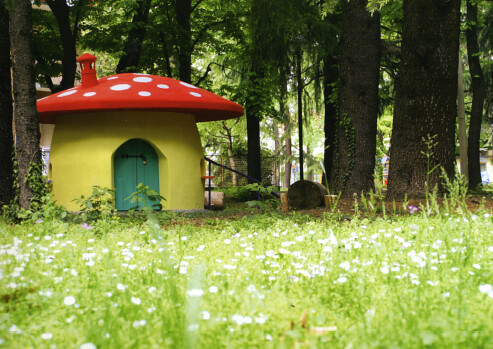A place for playing
The rediscover of an iconography linked to the childish imaginary is typical of the artist’s work since the beginning, like in No Frost (1990), where a bunch of Disney characters closed a refrigerator with a bar, depriving it of its function; or when a series of inflatable characters, superheroes and other cartoons, crowded the swimming pool of art curator Danilo Eccher on the occasion of the exhibition Numero Civico (1994); or, once again, in works such as La spada nella roccia (1998) o La fidanzata di Zorro (1999).
The usage of elements taken from the collective imagination goes with a deep reflection on space, that brings to the image of the house. The idea of the house as a place of hospitality and as a right comes from the workshops made with children for the project Zingonia. Arte integrazione multiculture in 2001. On that occasion, the artist proposed the workshop Ognuno ha una casa (Everybody has a house), with children coming from the Senegalese community. Every child was given a small house made of cardboard to furnish and decorate.
The house is everything, it’s your place, your space, your dignity. You organize it as you prefer, it’s your world, you live in it, it’s a place to meet the others, a private dimension, a place where you can imagine and build[1].
Liliana Moro, Ognuno ha una casa (Everyone has a home), 2001, cardboard structures, carpets, collages, variable dimensions. Made in the Zingonia project - art multicultural integration, exhibition in Comune di Ciserano, Bergamo. Photo Roberto Marossi, Milan. Collection of Ciserano, Bergamo.
A similar work, Casafungo, was realised in 2004 inside Parco Comunale of Gallarate Varese for the twentieth edition of Premio Nazionale Arti Visive Città di Gallarate, starting from the results of a series of workshops with children on the concept of “playing house”. The work has been locked up with a safety lock first and then removed after a series of acts of vandalism.
Liliana Moro, Casafungo, 2004, colored cement, Parco Comunale city of Gallarate – MAGA, Museo d’Arte Gallarate (now distroyed).
[1] Intervista a Liliana Moro, in E. De Cecco (ed), Zingonia. Arte integrazione multiculture, Milano, A&M Bookstore, 2002, p. 34.


